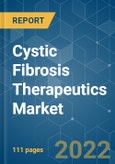The cystic fibrosis therapeutics market is anticipated to register a CAGR of nearly 9.1% during the forecast period. The increasing prevalence of cystic fibrosis (CF), coupled with the rising treatment rate, is one of the key factors expected to bode well for the market growth for these therapeutics. Moreover, a rising number of initiatives undertaken by nonprofit organizations, an increase in R&D funding by both private and public organizations, and supportive government legislation are some of the crucial factors expected to drive the market in the coming few years.
According to the data published by the Cystic Fibrosis Foundation, the incidence of these hereditary disorders is constantly growing. In 2019, there were more than 70,000 patients are living with cystic fibrosis. Increasing year-on-year growth in the number of patients further results in surging demand for efficient and effective CF therapeutics.
The rising number of potential clinical pipeline candidates is one of the key factors expected to propel the market growth. Moreover, upsurge in the number of clinical trials to expand its target patient base with the existing drug portfolio is also amongst some of the drivers of this market. Growing R&D activities are expected to propel market growth. Some of the pipelined drugs are Symdeko (tezacaftor + ivacaftor), VX-561, ELX-02 and ABBV-3067.
The presence of various nonprofit organizations, such as Cystic Fibrosis Worldwide, Cystic Fibrosis Foundation, Cystic Fibrosis Canada, South African Cystic Fibrosis Trust, and South African Cystic Fibrosis Association, which are consistently involved in the activities related to CF is also one of the pivotal factors that can be accounted for surging demand. These organizations are investing huge amount of funds to find various therapeutics for CF and to support the research and developmental activities by prominent players. However, high cost of the treatment may restrain the growth of the market.
Key Market Trends
CFTR Modulators Dominates the Market and is Expected to Continue to Do the Same during the Forecast Period
CFTR modulators are expected to dominate the cystic fibrosis therapeutics market through the forecast period. This can be attributed to new product launch, high commercial availability, and huge demand for these drugs to treat CF are expected to drive the segment. These modulators are designed to correct the malfunctioning protein made by the CFTR gene. For instance, recently launched ORKAMBI lead the way for segmental growth. This drug class directly cures the underlying cause of the disease.
Thus, the CFTR modulators segment is witnessing a shift toward combination therapies that provide enhanced results to patients. Higher availability, positive results, and reimbursement policies by key players for the target disease are supplementing the growth of the segment. Focus on developing new drugs to address the changing needs of the patients, such as TRIKAFTA and KALYDECO, in the treatment poised to create a significant shift in prescription patterns.
North America Represents the Largest Market and Asia-Pacific is Expected to Register Fastest Growth.
North America is at the forefront of growth in the region and is also an important revenue contributor in the global arena. Heightened awareness of disease remittance therapies among patients, rising prevalence of CF, and high public and private healthcare spending are stimulating the growth of the region. The United States has most of the people affected with CF who are of Caucasian descent. Furthermore, initiatives taken by CF Foundation and Cystic Fibrosis Canada are one of the key reasons that can be accounted for its largest share. Moreover, easy access to quality healthcare, favorable reimbursement policies, strong clinical pipeline, and approval of novel drugs are projected to promote revenue growth in North America.
The Asia-Pacific is likely to witness the fastest growth throughout the forecast period. The growing adoption of the urban lifestyle is leading to expanding the base of patients in the region. This, coupled with increasing healthcare spending, is expected to propel the market in APAC. Favorable regulatory policies for biosimilars are estimated to boost demand for the regional market over the forecast period.
Competitive Landscape
The key players are consistently involved in the development of new or combination of products to treat cystic fibrosis. Investment in the R&D is one of the strategic measures to beat the competition. The key players in this market are AbbVie Inc.; F. Hoffmann-La Roche Ltd; Gilead; Novartis AG; Vertex Pharmaceuticals Inc.; AIT (Advanced Inhalation Therapies); Alaxia; Teva Pharmaceutical Industries Ltd; Merck & Co. Inc.; Alcresta Therapeutics Inc.; Allergan; and AstraZeneca.
The players operating in the market focus on introducing new products to address the changing needs of the patients. For instance, in April 2019, the US Food and Drug Administration (FDA) approved Vertex Pharmaceuticals Incorporated’s KALYDECO (ivacaftor) with an aim of expanding the range of treatment options for the millions of children living with cystic fibrosis (CF). This allows physicians to begin treating the underlying cause of CF in eligible infants as young as six months of age for the first time, with the potential to modify the course of the disease.
Additional Benefits:
- The market estimate (ME) sheet in Excel format
- 3 months of analyst support
This product will be delivered within 2 business days.
Table of Contents
Methodology

LOADING...








